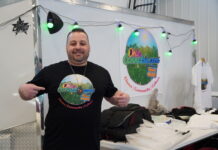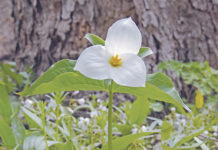
One of the great seasonal traditions among settlers in the Ohio Country was the husking bee or husking frolic.
In the late fall, neighbors went from one farm to the next to help one another with the laborious, blister-inducing job of husking the ears of corn brought in after the growing season. In a time when many farming families worked largely on their own for most of the year, seldom getting an opportunity to socialize with their neighbors except at church functions, the husking bees were a much-anticipated event in marking the close of the agricultural year.
Husking bees were done in the same tradition as barn raisings, quilting bees, firewood-making bees and stump-pulling bees. These bees, however, had nothing to do with buzzing pollinators. The word bee in this instance was an outgrowth of the Middle English word bene, meaning a prayer or favor. That evolved into a transformation of the word to biden (pronounced bee-den), an archaic New England term for an invitation.
Regardless of where the word originated, husking bees came about as a way for settlers to solve a common agricultural dilemma. A bountiful harvest of corn was a mixed blessing for farmers. While they might have an abundance on their hands, they might not have enough time — or hands — to husk (or shuck) it all. An obvious solution was to invite the neighbors over to help and, in return for their assistance, reward them with a meal and an evening’s entertainment.
To encourage the neighbors to come, the farmer would sweeten the pot with food, drinks, a few gallons of rum and dancing once the husking was done, transforming the event from labor into a party which often lasted far into the night and beyond.
In an 1825 work entitled “Brother Jonathan,” John Neal wrote that the meaning of an invitation to a husking bee meant that the farmer “cannot help himself (so) on such, or such a night he will permit all the ‘fellers’ and ‘gals’ to tumble and roll about in his barn, all night long if they please; eat his pumpkin pies, drink his cider and waste his apples; under the pretense of husking corn.”
But as the practice evolved, it became less about husking corn and more about the social aspects.
Neal wrote that what once had been an act of neighborly kindness “is now a wicked and foolish frolick at another man’s expense. Instead of husking corn, they husk the owner; trampling the products of his toil and push one another about; sometimes to the squalling of a bad fiddle.”
The primary tool involved in husking duties was the husking peg, and most participants brought their own to the gathering. The husking peg was a sharpened piece of material about 3 inches in length. Some of them were straight, while others were designed to wrap around the edge of the hand for greater stability. In every case, the peg had two holes drilled in it to accommodate the knotted ends of a cord or leather thong, the loop of which would allow two fingers of the user’s hand to go through.

Husking pegs, the purpose of which was to allow the user to more easily to slit the corn husk for the removal of the ear, were typically made of four different kinds of material. The first and most popular was wood. Wooden husking pegs could be simply whittled out with a knife or turned on a lathe for a bit more style. Another type of material was animal bone, which was sturdy and could retain the point in a well-sharpened condition. A more unusual type of peg was made from the sharp tip of a deer antler.
A fourth kind was an iron husking peg made by a blacksmith. Because of the blacksmith’s natural propensity for artistry, some husking pegs made by this craftsman went a bit beyond the mundane and occasionally included lathe-turned-work or stamped decoration. In every material, examples can be found that go beyond the functional and cross the line into the realm of folk art.
One of the most ingrained aspects of the husking bee and its related debauchery was that of finding a red ear of corn. Because the settlers were growing a type of maize that had multicolored kernels — much like today’s Indian corn — ears that had all red kernels were occasionally discovered. Tradition dictated that the finder of a red ear, be it a man or woman, was allowed to kiss anyone else at the gathering.
This practice was a perversion of a similar Iroquois tradition that said the discovery of a red ear meant only that one had a brave admirer.
At the husking bee, knowing matrons often vetted the newly husked ears before the kissing began because they frequently found that ordinary yellow corn ears had been painted red. At many such bees, red ears were found to be in abnormally plentiful supply and it was guessed that every young man had come with at least two stuffed in their pockets.
As the husking party, with its dancing, drinking and kissing went far into the night, young couples often took the opportunity to sneak off to other parts of the farm for some merrymaking, clothing husking and general debauchery of their own.
And you wonder why the husking bee is so fondly remembered in the Ohio Country…














